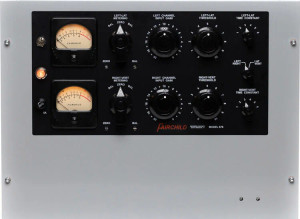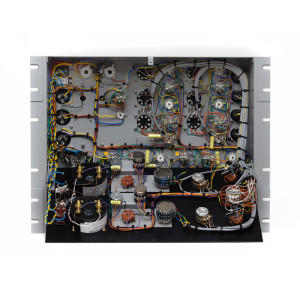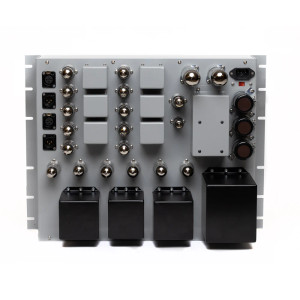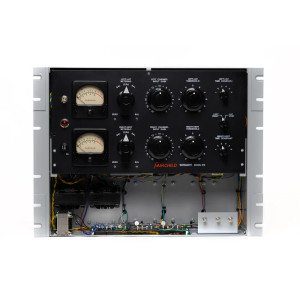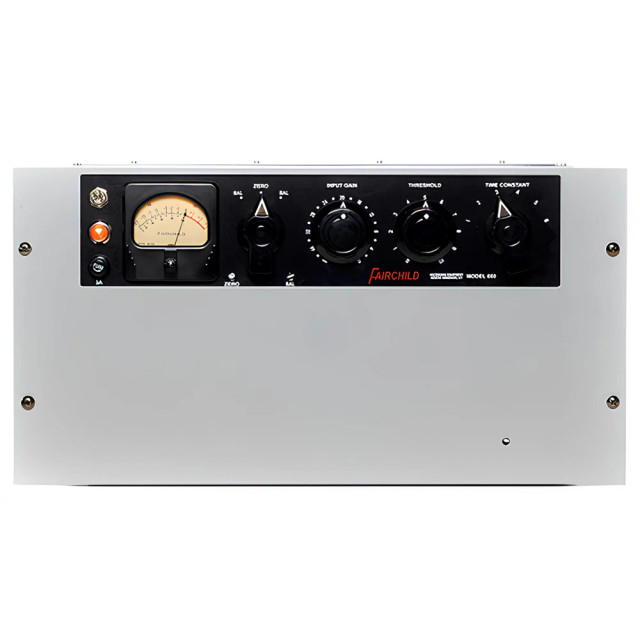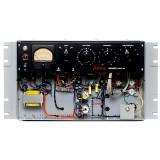Fairchild Recording Equipment
Fairchild Model 670 2-channel Tube Limiter/Compressor

Fairchild Model 670 2-channel Tube Limiter/Compressor
Fairchild Model 670 2-channel Tube Limiter/Compressor
2-channel Tube Limiter/Compressor with Dual-mono and Stereo Operation, Selectable Attack/Release Time Constants, Custom-designed transformers, and VU Metering
This is a special order item, please contact us for details: sales@stlaudio.co.nz
Fairchild 670: The Undisputed Heavyweight
There are a handful of truly classic dynamics processors, but the Fairchild 670 tube limiter/compressor is the undisputed industry heavyweight — and not because it weighs in at a hefty 65 pounds. In the estimation of many seasoned recording, mastering, and broadcast engineers, the Fairchild 670 stands as the finest such unit ever made. Coveted by audio pros for its inimitably smooth, creamy, and natural-sounding dynamics control and the warmth, depth, weight, and character that it imparts to any program material, the iconic Fairchild 670 has been heard on countless classic recordings of the 1960s, ’70s, and beyond. Less than 1,000 were ever built, and today the originals are exceedingly rare — even more so if you’re seeking one in good working condition.
The legend, reborn
Designed in the late 1950s, the Fairchild Model 670 was, even by the mil-spec standards of the day, over-engineered to deliver a natural, organic-sounding compressed signal along with an unprecedented degree of control thanks to distinctive features such as attack times ranging from a whiplash-inducing 10,000th of a second, a selection of release times adjustable from 0.3 seconds to 25 seconds, and dual-mono/stereo operation. With its beautiful compression characteristics, lightning-fast attack time, unique dual-channel vacuum tube circuitry, military-grade build quality, and unparalleled versatility, the original Fairchild 670 is reverentially considered the granddaddy of dynamics processors. Now, the iconic tube limiter is back to reclaim the title in a meticulously handcrafted re-creation of the legend, true to the original in every aspect.
Sound and performance like no other
The exquisite sound of vocals, instruments, stereo stems, and complete mixes processed through the Fairchild 670 is the result of a number of factors, including its discrete, handwired point-to-point circuitry infused with the beefy power of 20 tubes and 11 custom-wound transformers. An inherent sonic attribute of this type of “variable-mu” dynamics control is the gentle, soft knee of the compression curve, with fast attack and fairly long release times. It’s also program dependent, so gain reduction starts at a very low ratio on small peaks and gradually increases to brickwall territory on very loud input signals. Each half of the Fairchild 670 is driven by a single push-pull stage of audio amplification and a very high control voltage, thus ensuring that the automatic gain-controlled amplifier never produces audible audio artifacts such as the thumps and pumping common to many limiting amplifiers. The 670 exhibits extremely low distortion and vanishingly low noise under all conditions, both as a through amplifier and under maximum limiting conditions.
The control set
Due to the 670’s unique architecture, its control set is somewhat different from that of most other dynamics processors. It is equipped with a global switch that selects between stereo operation and lateral/vertical component operation. Per channel, there’s an input level control, a limiting threshold control, an attack/release switch that selects between six time constants, plus a limiting meter and metering selector switch. On the Fairchild, the DC threshold is adjusted via internal trim pots for adjustment over a wide range, from a seamless transition between compression and hard limiting to a harder, more pronounced knee. The compression ratio is dependent on the amount of limiting as well as the settings of the two continuously variable front-panel AC threshold controls, which can be set to operate at ratios from 1:2 to 1:30. The attack and release time constants are adjustable in six steps via per-channel front-panel switches:
- Position 1) .2ms / .3s
- Position 2) .2ms / .8s
- Position 3) .4ms / 2s
- Position 4) .4ms / 5s
- Position 5) .4ms / .2s individual peaks, 10s multiple peaks
- Position 6) .2ms / .3s individual peaks, 10s multiple peaks, 25s consistently high program levels
Dual-mono and stereo operation
Veteran recording engineers will understand the Fairchild 670’s “LAT/VERT” labeling as specific to lateral and vertical cutting lathe head excursion in vinyl disc mastering. But while vinyl is enjoying a resurgence and has overtaken CDs in market share, it nevertheless commands less than 10% of today’s mass-market music distribution, which is dominated by streaming. Although the 670 remains an essential tool for the vinyl mastering engineer, contemporary audio pros not involved in that lost art can interpret LAT/VERT and LEFT/RIGHT simply as “dual-mono“ and “stereo,” respectively. Having the ability to run the channels independently or linked for stereo operation gives you tremendous flexibility for optimally employing mid-side (M-S) processing, an encode-decode process in which the mid and side signals, after being separated by a hardware or software matrixing network, typically require different dynamics processing.
Ideal for mid-side processing
The mid and side components in M-S processing and the vertical and lateral components in vinyl disc cutting are analogous. In modern music production, many engineers and producers have discovered the advantages of mixing and mastering with mid-side processing. The Fairchild 670 incorporates two independent limiters that can limit either the left and right channels of a stereo mix or the mid and side (vertical and lateral) components thereof. The latter is executed by sending the two stereo mix channels through an encoding processor, dividing them into their respective components, which are then limited independently before being recombined through a decoding processor into left and right stereo channels. Effective mid-side processing results in mixes with increased width, depth, and focus.
A key component in vinyl disc mastering
Originally designed to address the need for effective level control in vinyl stereo disc mastering, the Fairchild 670 arrived on the scene when the stereo long-playing record was becoming established and co-existing alongside monaural LPs. Given that stereo disc grooves stored twice the amount of information as those of a mono LP, dynamic shaping of the program material was essential (as was stereo/mono compatibility). The 670, placed in front of a cutting lathe, gave the mastering engineer precise control over the (vertical) depth and (lateral) width of the grooves in order to ensure reliable playback on the consumer turntable systems of the day while maintaining sufficient program length and level for an LP to be competitive with other commercial releases. While today’s turntables, tonearms, cartridges, and styli are infinitely superior to those of yesteryear, optimized mastering for these systems is still relevant.
The ultimate tool for classic analog sound
A half-century on, the Fairchild 670 remains a key component in any serious mastering chain. But its delectable sonics, rock-star performance, and outstanding versatility make it indispensable at any stage of the recording process. It’s magic on vocals. The buttery-smooth sound of the vocals on Beatles’ records is largely thanks to the original Model 660, the mono version of the Fairchild, of which EMI Studios (Abbey Road) owned several. Through the 670, bass, guitars, drums, pianos, and orchestral instruments all take on new life and are easier to place in the mix. And come mix time, many engineers simply keep it strapped across the stereo master bus to achieve assertive, radio-ready mixes that blast right out of the speakers. However you use it, the Fairchild 670 has what it takes to elevate the sound of your studio to world-class status.
Fairchild Model 670 2-channel Tube Limiter/Compressor Features:
- The ultimate tool for classic analog sound
- Dual-mono and stereo operation
- Handwired point-to-point construction
- Tube-driven amplification
- Custom-designed transformers
- 6 selectable attack/release time constants
- Threshold, compression, and makeup gain controls
- VU limiting metering
STL Pro Audio is the exclusive NZ distributor for Fairchild Recording Equipment.

